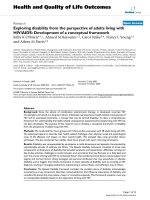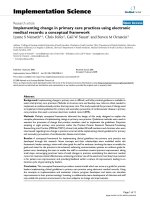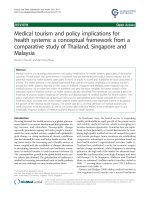Six sigma in service organizations a conceptual framework based on aspects of implementation and performance
Bạn đang xem bản rút gọn của tài liệu. Xem và tải ngay bản đầy đủ của tài liệu tại đây (3.01 MB, 343 trang )
SIX SIGMA IN SERVICE
ORGANIZATIONS: A CONCEPTUAL
FRAMEWORK BASED ON ASPECTS OF
IMPLEMENTATION AND
PERFORMANCE
AYON CHAKRABARTY
(M.E., BITS, Pilani, India)
(B.E., University of Rajasthan, Jaipur, India)
A THESIS SUBMITTED
FOR THE DEGREE OF DOCTOR OF PHILOSOPHY
DEPARTMENT OF INDUSTRIAL AND SYSTEMS ENGINEERING
NATIONAL UNIVERSITY OF SINGAPORE
2009
i
ACKNOWLEDGEMENT
Thanks will be a mere word to express my immense gratitude to all those who have
helped me in my research progress and more so in shaping my Ph. D into an enriching
and memorable experience. I wish to sincerely acknowledge here all the encouragement
and support I received directly or indirectly from different persons at different times.
The research guidance that I got through A/Prof. Tan Kay Chuan was much more than
what I wished for before coming to NUS. I express my sincere gratitude and countless
thanks to him for being a splendid supervisor. Without his immense support, timely
inputs, precise guidance and encouragement my progress was impossible. I fall short of
words to explain his influence on me and my research. In him, I have realized a guide, a
mentor, very good motivator, a good friend for life and more than all a complete human
being I can look up to. Thank you Sir; thanks a lot for everything.
I extend my thanks to Prof. Xie Min and Dr. Chai Kah Hin for their kind acceptance to be
on the panel of examiners and for valuable suggestions for planning this research during
the qualifying exam. I also do thank the final reviewers for spending time on evaluating
this thesis.
I wish to admire and thank the unknown reviewers of our publications, who gave
constructive feedbacks on all our manuscripts and helped us to bring out the best of this
research to the community.
I also express my sincere gratitude to all the professors at ISE/NUS whose valuable
lectures/seminars have put some intriguing thoughts in me, contributing good ideas to
this research.
ii
My experience as part time research assistant to the Office of Quality Management
(OQM) was truly enriching. I specially thank Prof. Tan for involving me in the new
projects and providing me a good chance to learn more. It was indeed a privilege to work
with him and others in OQM and a great value addition.
Special thanks to my department (ISE) for giving me an opportunity to be a teaching
assistant for both undergraduate and postgraduate students (which truly added a color to
my experiences at NUS) and also for financially supporting my conference visits.
My affectionate thanks to all my lab-mates and other friends at NUS for their fantastic
company and useful interactions. I additionally thank Usman Asad, Goudarzlou Atarod
and Zhou Qi for being a motivating flagship Ph.D student of our group. Friends, thanks a
lot for making the Ergonomics lab a great place to work and enjoy research. You all have
been part of my wonderful times in NUS.
At this moment when I am going for my highest qualification, I remember and thank all
my professors, students and precious friends who trained, tuned and inspired me to be
what I am today. The eventful journey, so far, would not have been wonderful without all
your contributions.
My family members are always the source of inspiration. They continue to motivate me
to do better in whatever I am doing. Their blessings and faith in me were the main driving
force during the course of my PhD. I dedicate my PhD to my parents as without their
unconditional sacrifice this work would not have been possible. I am ever grateful and
indebted to you all and specifically to my parents.
iii
TABLE OF CONTENTS
ACKNOWLEDGEMENT……………………………………………………….… … i
TABLE OF CONTENTS………………………………………………………… …iii
SUMMARY…………………………………………………………………….… … xiii
NOMENCLATURE…… ………………………………………………….…… xvi
LIST OF TABLES…………………………………………………………… …….xviii
LIST OF FIGURES……………………………………………………… … …… xxi
CHAPTER 1: INTRODUCTION………………………………………… ………… 1
1.1 Research Background………………………………………………………… 1
1.2 Research Objective…………………………………………………………… 3
1.3 Research Questions…………………………………………………………… 5
1.4 Purpose of this Thesis…………………………………………………… 5
1.5 Thesis Structure……………………………………………………………… 6
CHAPTER 2: LITERATURE REVIEW…………………………………………… 10
2.1 Introduction…… ………………………………………………………… …10
2.2 Literature Review Methods and List of Articles……………………………….10
2.3 The Classification Scheme…………………………………………………… 12
2.4 Literature Trends………………………………………………………… … 14
2.5 Literature Research Topics and Methods………………………… ………….18
2.6 Six Sigma Definitions and Philosophy………………………………… …….21
2.7 Tools and Techniques and Six Sigma Methodologies……….………… ……24
2.7.1 Classification Scheme of Tools and Techniques………………… ……26
2.7.1.1 ASQ Classification……………………………………….… ….26
iv
2.7.1.2 Tool Matrix………………………………………………… ….27
2.7.1.3 Innovation Tools………………………………………… …….27
2.7.2 Six Sigma Methodologies…………………………………………….…28
2.7.2.1 DMAIC Methodology………………………………………… 28
2.7.2.2 Design for Six Sigma (DFSS): Overview………………….……29
2.8 Critical Success Factors (CSFs)………………………………………….……33
2.9 Critical-to-Quality (CTQ) Characteristics…………………………….….… 37
2.10 Key Performance Indicators (KPIs)……………………………………… ….40
2.11 Six Sigma in Manufacturing and Service Organizations………………….… 43
2.12 Literature Review Summary……………………………………………… ….46
2.13 Total Quality Management…………………………………………………….48
2.13.1 TQM Adoption………………………………………………………… 48
2.13.2 Identification of TQM Dimensions………………………………………49
2.13.3 Obstacles to TQM……………………………………………………… 51
2.14 Conclusion……………………………………………………………… ……53
CHAPTER 3: DEVELOPMENT OF FRAMEWORK….………………………….56
3.1 Introduction……………………………………………………………………56
3.2 Six Sigma Implementation Framework……………………………………… 56
3.2.1 Implementation………………………………………………………… 56
3.2.2 Framework……………………………………………………………….57
3.2.3 Proposed Framework…………………………………………………….58
3.2.3.1 Critical Success Factors (CSFs)……………………………….…60
3.2.3.2 Critical-to-Quality (CTQ) Characteristics ………………… 61
v
3.2.3.3 Key Performance Indicators (KPIs)…………………………… 62
3.2.3.4 Set of Tools and Techniques (STTs)……………………… 62
3.3 Conclusion…………………………………………………………………….63
CHAPTER 4: RESEARCH METHODOLOGY…………………………………….64
4.1 Introduction………………………………………………… …………… …64
4.2 Research Methodology……………………………………… ………….……65
4.2.1 Grounded Theory……………………………………… ………….……65
4.2.2 Key Elements of Grounded Theory……………………… ………….…67
4.2.2.1 Theory Building…………………………………… ……….… 67
4.2.2.2 Multiple Case Studies……………………………… ……….….68
4.2.2.3 Practitioner Involvement…………………………… ……….…69
4.2.2.4 Triangulation………………………………………… …………71
4.3 Three-Phase Approach……………………………………………….……… 71
4.3.1 Phase I - Macro Study………………………………….………….…… 72
4.3.2 Phase II – Small-Scale Questionnaire Survey and Case Studies…….… 73
4.3.2.1 Small-Scale Questionnaire Survey………………………………73
4.3.2.1.1 Structure of the Questionnaire…………………….…… 73
4.3.2.1.2 Questionnaire Design…………………………………….75
4.3.2.2 Case Studies…………………………………………….……… 76
4.3.2.2.1 Sample Selection………………………………….…… 76
4.3.2.2.2 Data Collection Procedure……………………………….78
4.3.2.2.2.1 Documentation……………………………… …78
4.3.2.2.3 Unit of Analysis……………………………………….…79
vi
4.3.3 Phase III – Large-Scale Questionnaire Survey and Case Studies…… …81
4.3.3.1 Case Studies…………………………………………………… 81
4.3.3.1.1 Data Collection Procedure…………………………….…81
4.3.3.1.1.1 Interviews……………………………….……… 81
4.3.3.1.1.2 Participation in Projects………………………….84
4.3.3.1.1.3 Documentation………………………………… 85
4.3.3.2 Large-Scale Questionnaire Survey…………………………… 85
4.3.3.2.1 Structure of the Questionnaire………………………… 85
4.3.3.2.2 Questionnaire Design……………………………………86
4.4 Response Variables…………………………………………………………….87
4.5 Targeted Population……………………………………………………………90
4.6 Survey Implementation……………………………………………………… 91
4.7 Testing for Sampling Bias…………………………………………………… 92
4.8 Conclusion…………………………………………………………………… 93
CHAPTER 5: PHASE I: MACRO STUDY………………………………………… 94
5.1 Introduction…… ……………………………………………………….… …94
5.2 Phase I – Macro Study…………………………………………….……… 94
5.2.1 Data Collection Procedure……………………………………………….94
5.2.1.1 Interview…………………………………………………………94
5.2.1.2 Documentation………………………………………………… 95
5.2.2 Case Study 1: ESERV1……………………………………………… 95
5.2.2.1 Background……………………………………………….….… 95
5.2.2.2 Data Analysis……………………………………………… … 96
vii
5.2.2.2.1 Findings…… ……………………………………… …96
5.2.2.3 Discussion………………………………………………….… 96
5.2.2.3.1 Implications………………………………………… …97
5.2.2.3.2 Limitations………………………………………… … 98
5.2.3 Case Study 2: ESERV2…………………………………………………98
5.2.3.1 Background…………………………………………….……… 98
5.2.3.2 Data Analysis……………………………………………………98
5.2.3.2.1 Findings…………………………………………….……99
5.2.3.3 Discussion………………………………………………….… 100
5.2.3.3.1 Implications……………………………………… ……100
5.2.3.3.2 Limitations…………………………………………… 101
5.3 Conclusion……………………………………………………………………101
CHAPTER 6: SMALL-SCALE QUESTIONNAIRE SURVEY……………….….102
6.1 Introduction……………………………………………………………………102
6.2 Small-Scale Questionnaire Survey……………………………………………103
6.2.1 Preliminary Analysis……………………………………………………103
6.2.1.1 Number of Responses……………………… ……………… 103
6.2.1.2 Respondent Profile………………………………… ……… 104
6.2.1.3 Organization Profile…………………………… …………… 105
6.2.2 Descriptive Analysis………………………………… ………….……106
6.2.2.1 Critical Success Factors (CSFs)………………… ………… 106
6.2.2.2 Critical-to-Quality (CTQ) Characteristics……….………….…107
6.2.2.3 Key Performance Indicators (KPIs)…………….…………… 107
viii
6.2.2.4 Set of Tools and Techniques (STTs)………………………… 107
6.2.2.5 Reasons for not Implementing Six Sigma………………… …110
6.3 Conclusion……………………………………………………………………111
CHAPTER 7: CASE STUDIES…… …………………………… …113
7.1 Introduction……………………………………………………………… …113
7.2 Case Studies……………………………………………………….………….113
7.2.1 Multiple Case Studies (SERV1 – SERV14)……………….……… …113
7.2.1.1 Six Sigma in Singapore Public Service Organizations……… 113
7.2.1.2 Data Analysis…………………………………….…………… 119
7.2.1.2.1 Findings……………………………………………… 125
7.2.1.3 Discussion…………………………………………… 126
7.2.1.3.1 Implications………………………………………… …126
7.2.1.3.2 Limitations……………………………….…………… 128
7.2.2 Case Study 1 (Serv15)…………………………………………….……128
7.2.2.1 Six Sigma at Starwood Hotels and Resorts………………….…128
7.2.2.2 Data Analysis………………………………………………… 131
7.2.2.2.1 Findings……………………………………………… 133
7.2.2.3 Discussion………………………………… ………………….135
7.2.2.3.1 Implications…………………………… …………… 135
7.2.2.3.2 Limitations…………………………………………… 136
7.2.3 Case Study 2 (SERV16)……………………………….………………136
7.2.3.1 Six Sigma at the Hospital…………………….…….………… 136
7.2.3.2 Data Analysis……………………………….…………….……138
ix
7.2.3.2.1 Findings…………………………………….…… … 145
7.2.3.3 Discussion…………………………………….…….………… 145
7.2.3.3.1 Implications…………………………….………………146
7.2.3.3.2 Limitations………………………………….………… 147
7.2.4 Case Study 3 (SERV17)……………………………………………… 148
7.2.4.1 Six Sigma at Construction and Related Engineering Service
Organization…………………………………………………………148
7.2.4.2 Data Analysis………………………………………………… 149
7.2.4.2.1 Findings……………………………………………… 151
7.2.4.3 Discussion………………………………………………………153
7.2.4.3.1 Implications…………………………………………… 154
7.2.4.3.2 Limitations…………………………………………… 156
7.2.5 Case Study 4 (SERV18)……………………………………………… 156
7.2.5.1 Six Sigma at the Consultancy Service Organization………… 156
7.2.5.2 Data Analysis………………………………………………… 157
7.2.5.2.1 Findings……………………………………………… 158
7.2.5.3 Discussion…………………………………………………… 159
7.2.5.3.1 Implications…………………………………………….160
7.2.5.3.2 Limitations…………………………………………… 161
7.3 Conclusion……………………………………………………………………161
CHAPTER 8: LARGE-SCALE QUESTIONNAIRE SURVEY…………………162
8.1 Introduction………………………………………………………………… 162
8.2 Large-Scale Questionnaire Survey………………………………………… 162
x
8.2.1 Preliminary Analysis……………………………………………………162
8.2.1.1 Number of Responses……………………………………… 162
8.2.1.2 Respondent Profile………………………………………… 163
8.2.1.3 Organization Profile……………………………………….… 165
8.2.2 Descriptive Analysis……………………………………………………166
8.2.2.1 Critical Success Factors (CSFs)………………………….…….166
8.2.2.2 Critical-to-Quality (CTQ) Characteristics……………….…… 167
8.2.2.3 Key Performance Indicators (KPIs)……………………………168
8.2.2.4 Set of Tools and Techniques (STTs)………………………… 169
8.2.2.5 Difficulties in Implementing Six Sigma………………….…….171
8.2.2.6 Reasons for not Implementing Six Sigma…………………… 172
8.3 Conclusion……………………………………………………………… … 174
CHAPTER 9: DISCUSSION AND FRAMEWORK CONSOLIDATION……….175
9.1 Introduction………………………………………………………………… 175
9.2 Micro-Level Analysis………………………………………………….… 175
9.2.1 Cross-Survey Analysis…………………………………………………175
9.2.1.1 Critical Success Factors (CSFs)……………………………… 175
9.2.1.2 Critical-to-Quality (CTQ) Characteristics…………………… 177
9.2.1.3 Key Performance Indicators (KPIs)……………………………178
9.2.1.4 Set of Tools and Techniques (STTs)………………………… 179
9.2.1.5 Difficulties/Reasons for not Implementing Six Sigma……… 181
9.2.2 Determining Six Sigma Success and Progress……………………… 183
9.2.2.1 Level of Success…………………………………………….….183
xi
9.2.2.2 Level of Progress…………………………………………….…187
9.2.2.2.1 Matrix of Six Sigma Success and Progress………….…191
9.2.2.3 Service Strategy Context………………………………………192
9.2.2.3.1 Matrix of Service Types…………………………….….197
9.3 Codes and Coding……………………………………………………………198
9.4 The Framework Consolidation 201
9.4.1 Critical Success Factors (CSFs)……………………………………… 203
9.4.2 Critical-to-Quality (CTQ) Characteristics …………………………… 204
9.4.3 Key Performance Indicators (KPIs)……………………………………205
9.4.4 Set of Tools and Techniques (STTs) ………………………………206
9.4.5 Difficulties or Barriers in Six Sigma Implementation 207
9.5 Conclusion 208
CHAPTER 10: CONCLUSION……………………………………………… …….210
10.1Introduction………………………………………………………………… 210
10.2 Answering Research Questions………………………………………………211
10.2.1 Research Question 1……………………………………………………211
10.2.1.1 Critical Success Factors (CSFs)……………………………… 212
10.2.2 Research Question 2……………………………………………………214
10.2.2.1 Service Organizations and Six Sigma Implementation……… 214
10.2.3 Research Question 3……………………………………………………216
10.2.3.1 Set of Tools and Techniques (STTs)…….…………… 216
10.3 Formulation of a Theory…………………………………………………… 217
10.4 Contribution to Research Process…………………………………………….218
xii
10.5 Contribution to Practice………………………………………………………219
10.6 Final Discussion and Future Directions………………………………………220
10.6.1 Six Sigma Implementation and Success, Progress, and Service Types 220
10.6.2 Six Sigma Implementation and Service Organizations……………… 222
10.7 Conclusion……………………………………………………………………223
REFERENCES…………………………………………………………………… …225
APPENDIX A: Online Resources for Six Sigma Literature……………………… 257
APPENDIX B: The Article Database……………………………………………… 258
APPENDIX C: Questionnaire Administration (Small-Scale Survey)…………… 267
APPENDIX D: Questionnaire Administration (Case Study)………………………277
APPENDIX E: Case Study Protocol: Six Sigma in Service Organization……… 284
APPENDIX F: Background Descriptions of Case Studies……………….……… 293
APPENDIX G: Questionnaire Administration (Large-Scale Survey)…………… 301
APPENDIX H: Respondents Database (Small-Scale Survey, Case Studies, and
Large-Scale Survey)………………………………………………………………… 313
PUBLICATIONS 319
xiii
SUMMARY
Six Sigma has become a frequently used term in discussions regarding quality
management. The international and national competitive environment is in a process of
constant change by the globalization of markets and the increased independence of
economic agents. This process of change has brought increased demands on the
organizations’ competitiveness and customers have gained a central role in organizations’
focus. Six Sigma is considered to be an important management philosophy, which
supports organizations in their efforts to obtain satisfied customers.
However, as Six Sigma has become a strategic necessity for service organizations, a large
number of tools and techniques have been suggested by academics and practitioners for
its implementation. Intriguingly, despite the extensive effort that has been invested and
benefits that can be obtained, the systematic implementation of Six Sigma in service
organizations is limited. Furthermore, diversity among researchers exists regarding actual
benefits of Six Sigma and its suitability to service organizations. The role and
contribution, which service organizations make to the economy, has become widely
recognized. As service organizations have been slow to adopt Six Sigma, issues
concerning its implementation in services are of major importance.
This research work presents results from two aspects. The first concern is with the
estimation of success and progress of service organizations due to Six Sigma
implementation. This is accomplished by conducting a large-scale survey of service
organizations situated in different geographic locations. The results obtained by
analyzing the responses indicate that mainly mass services have implemented Six Sigma
throughout the organization and they are the most successful and progressive. The use of
xiv
tools and techniques is also different among successful and less successful organizations.
Successful service organizations use less number of tools and techniques compared to
less successful organizations.
The second aspect is related to development of a conceptual framework on Six Sigma
implementation in service organizations using grounded theory methodology. The focus
here is on critical success factors (CSFs), critical-to-quality (CTQ) characteristics, key
performance indicators (KPIs), and set of tools and techniques (STTs). The data is
collected through surveys (small-scale and large-scale) and case studies. Small-scale
survey was conducted in Singapore service organizations. There are 18 case studies for
this study. The case studies have been conducted by studying service organizations in
Singapore which have implemented Six Sigma. The analysis of data from surveys and
case studies indicates that some of the CSFs, which are often described as the key
ingredients, are more adequate than the others when initiating Six Sigma implementation.
These CSFs are top management commitment, support of team members, and customer
focus. The results also point out CTQs varies across service types and the term KPI is
interpreted as similar to CTQ. There is difference in usage of STTs between successful
and less successful Six Sigma service organizations. In addition the study also visualizes
that CSFs, CTQs, and STTs vary across service types. The findings also indicate
difficulties faced in Six Sigma implementation by service organizations, which shows,
rather than the difficulty of data collection; part-time involvement, extension of project
timeline, and staff turnover during projects or after training are the major difficulties.
Unknown to us as a reason for not implementing Six Sigma prompts us to further
xv
understand the unique nature of service organizations and provide a customized approach
to Six Sigma implementation in service organizations.
xvi
NOMENCLATURE
ANOVA
Analysis of Variance
BB
Black Belt
BrB
Brown Belt
BS
Brainstorming
CC
Control Chart
CEA
Cause and Effect Analysis
COPQ
COQ
Cost of Poor Quality
Cost of Quality
CS
Check Sheet
CSF
Critical Success Factor
CTQ
Critical
-
to
-
Quality
DFSS
DM
Design for Six Sigma
Decision Matrix
DMAIC
Define, Measure, An
alyze, Improve, Control
DOE
Design of Experiments
FC
Flowchart
FD
Fishbone Diagram
FMEA
Failure Mode Effect Analysis
GB
Green Belt
HG
Histogram
I-MR
KPI
Individual Moving Range
Key Performance Indicator
xvii
MBB
Master Black Belt
MD
Matrix Diagram
MP
Mistake Proofing
NPP
Normal Probability Plot
PA
Pareto Analysis
PC
Process Capability
PM
Project Management
QM
Quality Management
RCA
Root Cause Analysis
RD
Relations Diagram
RGCA
Regression and Correlation Analysis
SD
Scatter Diagram
SIPOC
SPC
S
upplier, Input, Process, Output, Customer
Statistical Process Control
STT
Set of Tools and Techniques
TD
Tree Diagram
TQM
Total Quality Management
VOB
VOC
WFD
Voice of Business
Voice of Customer
Work Flow Diagram
YB
Yellow Belt
xviii
LIST OF TABLES
Table 2.1
Table 2.2
Table 2.3
Table 2.4
Table 2.5
Table 2.6
Table 2.7
Table 2.8
Table 2.9
Table 2.10
Table 2.11
Table 2.12
Table 2.13
Table 4.1
Table 4.2
Table 4.3
Table 4.4a
Table 4.4b
Table 5.1
Table 5.2
List of journals, magazines or proceedings with at least one article in the
study
Descriptors used to classify articles (adapted from Brady, 2005)
Articles in services with citation more than one
Pioneers of quality and their contribution to Six Sigma knowledge bank
(adapted from Wortman, 2001)
Classification of tools and techniques according to ASQ
Tool Matrix (Tague, 1995)
Innovation tools
DMAIC methodology (Chua, 2001)
CSFs for Six Sigma implementation
Critical-to-quality definitions
Key performance indicator definitions
Application of Six Sigma in manufacturing and service organizations
CSFs, CTQs, KPIs, and STTs (manufacturing versus service)
Service organizations and number of projects
Linking research questions with unit of analysis
List of interviewees
T-test for bias: small-scale survey
T-test for bias: large-scale survey
Data collection source
Comparison of CTQs
xix
Table 5.3
Table 6.1
Table 6.2
Table 6.3
Table 6.4
Table 6.5
Table 7.1
Table 7.2
Table 7.3
Table 7.4
Table 7.5
Table 7.6
Table 7.7
Table 7.8
Table 7.9
Table 7.10
Table 7.11
Table 7.12
Important library CSFs, CTQs, KPIs
,
and STTs determined from the case
study
Response rate: small-scale survey
Profile of respondents: job title of respondents and company size: small-scale
survey
Frequency of usage of STTs at different phases of DMAIC: small-scale
survey
STTs that are used at all phases of DMAIC: small-scale survey
Reasons for not implementing Six Sigma
Description of Six Sigma training at different level
Check list matrix: conditions supporting preparedness for Six Sigma project
CTQs in the projects
Tools and techniques used in the projects
Summary of findings: Public service organizations
Areas or processes where Six Sigma is applied
Summary of findings: Starwood Hotels and Resorts
Number of articles on Six Sigma at SWHR in different sources
Six Sigma projects at the Hospital
Check list matrix: conditions supporting preparedness for Six Sigma project
at the Hospital
Summary of findings: Hospital
Six Sigma projects at Construction and related engineering service
organization
xx
Table 7.13
Table 7.14
Table 8.1
Table 8.2
Table 8.3
Table 8.4
Table 8.5
Table 9.1
Table 9.2
Table 9.3
Table 9.4
Table 9.5
Table 9.6
Table 9.7
Table 9.8
Table 9.9
Table 9.10
Summary of findings
:
C
onstruction and related engineering
service
organization
Summary of findings: Consultancy service organization
Response rate: large-scale survey
Profile of respondents: job title of respondents and company size: large-scale
survey
Profile of service organizations: type, sector, and country
Frequently used STTs in each phase of DMAIC
STTs that are used at all phases of DMAIC: large-scale survey
Ranking of CSFs in individual surveys based on average scores
Definitions of KPI from large-scale survey
STTs as per different phases of DMAIC: Summarized from two surveys
Indicators and their score for determining level of success
Indicators and their score for determining level of progress
Frequently used tools and techniques by the organizations in low and
moderate progress categories
The matrix of Six Sigma progress and success
The matrix of service types
List of descriptive codes
STTs for service organizations
xxi
LIST OF FIGURES
Figure 1.1
Figure 2.1a
Figure 2.1b
Figure 2.2a
Figure 2.2b
Figure 2.3
Figure 2.4a
Figure 2.4b
Figure 2.5
Figure 2.6
Figure 2.7
Figure 2.8
Figure 2.9
Figure 2.10
Figure 3.1
Figure 4.1
Figure 4.2
Figure 4.3
Figure 4.4
Figure 6.1
Structure of t
hesis
The yearly number of Six Sigma articles in manufacturing and their authorship
The yearly number of Six Sigma articles in services and their authorship
Six Sigma articles in manufacturing and authorship percentage
Six Sigma articles in services and authorship percentage
Distribution of articles in different services
Pareto chart of articles in manufacturing by research approach
Pareto chart of articles in services by research approach
Box plot of impact factors of publications associated to authorship
Box plot of impact factors of publications associated to business sectors
DFSS versus Six Sigma (Ferryanto, 2005)
Percentage of articles mentioning each of 19 CSFs
Understanding critical-to-quality (adapted from Muir, 2006)
Levels of TQM adoption (Lascelles and Dale, 1991)
The framework for implementing Six Sigma in service organizations
Graphical representation of the research process
Modified grounded theory research methodology (adapted from Leonard and
McAdam, 2001)
Three-phase approach (adapted from Leonard and McAdam, 2001; Gilmore and
Carson, 1996)
Interview protocol for the interviews (adapted from Nonthaleerak and Hendry,
2008)
Data analysis map (adapted from Boyer et al., 2002)
xxii
Figure 6.2
Figure 6.3
Figure 7.1
Figure 7.2
Figure 7.3
Figure 7.4
Figure 7.5
Figure 8.1
Figure 8.2
Figure 8.3
Figure 8.4
Figure 8.5
Figure 8.6
Figure 8.7
Figure 8.8
Figure 9.1
Figure 9.2
Figure 9.3
Figure 9.4
Figure 9.5
Figure 9.6
Figure 9.7
Distribution of service organizations
Frequency of usage of STTs by service organizations: small-scale survey
Proposed approach for Six Sigma implementation in Public Service in Singapore
Phase III Six Sigma training structure
Commonly used tools and techniques in public service projects
Six Sigma journey at Starwood
Context chart for Six Sigma projects at DEM
Skill profile of respondents of Six Sigma organizations
Average score for 9 critical success factors
Response frequency for critical-to-quality characteristics
Response frequency for key performance indicators
Frequency of usage of STTs by service organizations: large-scale survey
Difficulties faced in Six Sigma implementation
Reasons from organizations which have already implemented Six Sigma
Reasons from organizations which have not implemented Six Sigma
Average score of CSFs in large-scale and small-scale survey
Count of CTQs in large-scale and small-scale survey
Average score of STTs in large-scale and small-scale survey
Average score of STTs in low and moderately successful Six Sigma
organizations
The responses on difficulties faced during Six Sigma implementation from low
and moderately successful service organizations
Average score of STTs in low and moderately progressed Six Sigma
organizations
Service process model (Silvestro et al., 1992)
xxiii
Figure 9.8
Figure 9.9
Figure 9.10
Figure 9.11
Figure 9.12
Figure 10.1
Average score of CSFs as per service types
CTQs as per service types
Average score of STTs as per service types
List of pattern codes
Conceptual framework for Six Sigma implementation in service organizations
The research questions formulated to address the aims of this thesis
Chapter 1 Introduction
1
CHAPTER 1 INTRODUCTION
1.1 Research Background
Quality management has long been established as an important strategy for achieving
competitive advantage. The aim of the businesses may differ, but the importance of
customers is a matter of common interest. The ability of the organizations to adapt to new
customer requirements in a globalized market is of vital importance for long-term
success. Traditional quality initiatives such as statistical quality control, zero defects, and
total quality management, have been key initiatives for many years. In last two decades,
Six Sigma evolved as a new quality management initiative and now many organizations
1
are working towards its implementation.
Six Sigma is a disciplined approach for improving manufacturing or service processes,
based on defined metrics (Hahn et al., 1999). The strength of Six Sigma lies in its well
defined framework involving methodology applying different tools and techniques (Goh,
2002). The Six Sigma journey started from Motorola in 1980s and spread its importance
through adoptions by different high profile organizations such as General Electric (GE),
Honeywell, Asea Brown Bovari (ABB), Lockheed-Martin, Polaroid, and Texas
Instruments (Goh, 2002; Hahn et al., 1999). This initial success of Six Sigma has seen its
implementation spreading in several other organizations mostly in mass-manufacturing
sector (McAdam et al., 2005). These organizations adopted the systematic framework of
Six Sigma through training and project management practices (Brady and Allen, 2006).
The use of Six Sigma has been relatively high among many western organizations till
1
The terms “organization” and “company” are used synonymously in this thesis to refer to a private or
public owned producer of goods or services









